Johnny the Homicidal Maniac: A Monster Makes the Hero’s Journey
In Jhonen Vasquez’s seven issue comic series Johnny the Homicidal Maniac (JTHM) the protagonist is a literary monster who takes the form of the profoundly disturbed and twisted character simply known as Johnny C. aka Nny. This character is violent, vicious and unpredictable, but there is something likeable about him. He has qualities and a story that are arguably heroic, and it is this seemingly contradictory nature that creates a memorable character that we cannot help but feel for.
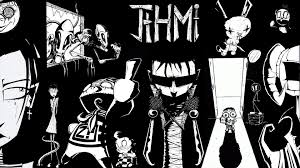
The Merriam-Webster dictionary offers a definition of the word monster which includes: one who deviates from normal or acceptable behavior or character, a threatening force, and something monstrous; especially a person of unnatural or extreme ugliness, deformity, wickedness, or cruelty. As one who blatantly fits into all three of these possible definitions of a monster, it is safe to say that Nny qualifies. This is apparent through simple observation of his hideous crimes against his fellow humans as well as animals and supernatural beings. However, Nny’s monstrosity goes far beyond his actions. For a more in depth look at what makes Johnny a true monster, we turn to Jeffery Jerome Cohen and his seven theses regarding the traits which qualify someone or something monstrous.
Cohen’s first thesis states that the monster’s body is a cultural body, meaning that an investigation into the nature of the monster will reveal part or all of the culture by which the monster was created. We see this in Johnny’s rants about our society, as well as in the victims he chooses. He was born of a culture of filth and rudeness so he targets those individuals who contribute to the problems he perceives within our society. Also given that the publication dates in which Nny came to life were in the mid to late 1990s, Johnny reflects the grunge culture and the people’s pessimistic and skeptical nature which, thanks to a boom in media outlets and the popularization of the internet, was climbing to its peak during the time of his inception.
There is no doubt the Nny fulfills the requirement for the second thesis which simply states “the monster always escapes”. Throughout the series, Nny commits very lengthy, elaborate, and very public mass executions after which he seems to simply leave the scene with no regard for hiding his crimes or removing evidence which could connect him to said crimes. He advertises via a sign on his front lawn that corpses are buried within the freshly overturned soil, and he leaves more than one corpse on his front porch in broad daylight. In spite of all of this, Nny is never found, confronted or detained by the authorities, let alone captured in any way. Johnny spends many panels pondering and commenting on his invulnerability and having his escapes remarked on by others. In addition to incarceration, Johnny regularly avoids death. His multiple failed suicide attempts lead him to believe that he is invulnerable and that a higher power is granting him this ability.
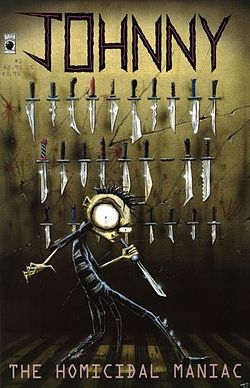
The third thesis states “the monster is the harbinger of category crisis”. Simply put, the monster escapes because it evades all attempts at categorization. We do not know Johnny’s last name, race, religion, or upbringing. All of these unknowns make him a mystery and significantly complicate the process of categorization. His moral compass is also hazy at best. In one scene, he murders several café patrons and admits that some of them may be victims who have not contributed to the negativity he wishes to expel; regardless he goes on to slaughter them indiscriminately. In another scene, Nny spends several pages conversing with a man in a Saw-like killing machine. He admits the man’s innocence and expresses regret towards the fact that the man must play the role of sacrifice to keep contained the monster within Nny’s wall. He can clearly distinguish between those who contribute to the problems within our society and those who are victims, but on at least these two occasions he disregards his own shaky guidelines by murdering innocents and thus blurring our interpretation of his morality even further.
Difference is Cohen’s fourth requirement. Johnny represents the minority in a variety of ways. He is abnormally thin, he wears darker clothes than most people would deem appropriate outside of a funeral home. His clothing style is best labeled as ‘Goth’ which is part of the alternative or anarchist subculture. He also represents a mindset which most of us would claim differs greatly from the norm. He expresses his frustrations with culture and humanity in a way that most, ideally all, of us would consider the antithesis to what we perceive as our standardized morality.
The fifth thesis describes how the monster is meant to act as a warning against the unknown. A monster is designed to be the most conceivably negative reflection of the unknown or unexplored areas of the world and of our minds. It is meant to shock and frighten us thereby limiting our desire to reach beyond the comfortable boundaries of the familiar. We have all at one point or another felt anger towards a stranger who was less than amicable to us. We may have even had an urge to wish them ill or do them harm in some way. JTHM understands that we have these thoughts and feelings and chooses to use Johnny as a means of pushing them until he represents those urges at their extreme. The violence and horror committed by Nny are meant to frighten us and repulse us away from the exploration of our darker sides.
The next to last thesis states that our fear of the monster stems from our hidden desires. As previously stated, throughout the JTHM series Johnny commits atrocious acts against individuals he perceives as rude, vulgar, and/or insolent. He acts with abandon and without repercussion. This is desirable because as a culture, we often find ourselves wishing we could act with impunity thereby fulfilling some of our more basic needs and desires. How many of us have joked about robbing a bank to pay our bills or commented that we would like nothing more than to tell our superiors just what we think of them? We use humor and hypotheticals when expressing these wishes because we know that we are vulnerable and would be subject to consequence if we acted on these darker impulses. The most attractive quality of the monster is that it will always be without restriction and free to act as it desires in a way we can only experience vicariously.
Cohen’s seventh and final thesis declares that the monster stands at the threshold of becoming. The mere presence of a monster like Nny causes us to confront those ideas which are otherwise unexpressed and intangible. Cohen states that “they [the monsters] bear self-knowledge, human knowledge”. He also states that this knowledge is more powerful and effective because it comes from a place outside our limited scope of human perception. We use the monster’s eyes to view our culture in new ways. With Johnny, the issues of morality, identity, faith, culture, decay, accountability and many others are brought to light through a twisted yet disturbingly unbound and honest interpretation. Without direct command, Johnny asks us to unapologetically question every aspect of ourselves and our world the way he questions himself and his.
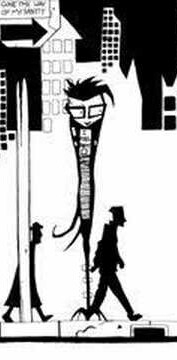
Again, we look to Merriam-Webster’s dictionary which defines a hero in a number of ways. A hero could be an illustrious warrior, a man admired for his achievements or noble qualities, or the central male figure in a literary work. Nny could be called an illustrious warrior due to his proficiency with a variety of weapons and his efficiency with which he dispatches his foes. He is certainly the central male figure in a literary work, and Nny does pick up a follower who admires him for what the follower, Jimmy, deems to be great achievements and noble pursuits.
With this definition in mind, we pan out to view Nny in the context of his story as a whole, and it is not surprising that the events of JTHM fit very closely with what Joseph Campbell outlined what is called the ‘monomyth’ or ‘the hero’s journey’ in his work “Hero With a Thousand Faces”. The hero’s journey is the seventeen step route or cycle which most heroes of myth and classical literature undertake. The monster Nny’s story is among the many who fulfill this outline.
The first of the three major story segments is called the separation which features five stations including: the call to adventure, the refusal, the supernatural aid, crossing the threshold, and the belly of the whale. For Nny, the call to adventure first comes when the character known as Psychodoughboy encourages him to commit suicide which would allow Nny to be freed from the mundane. This first call is diffused by a minor character who is outside the situation. The call to adventure comes again when Psychodoughboy attempts to persuade Nny to take his life, but is refused by Johnny himself because he believes he cannot die thanks to the involvement of a supernatural force. The supernatural aid in Nny’s story is Nail Bunny who acts as the sole voice of reason and stability in Nny’s otherwise psychotic and unreliable world. Bunny tries to reason with Nny and encourages him to try to return to a more normal and happy place though his warnings and advice go largely unheeded.
The crossing of the threshold comes when Johnny accidentally commits suicide. As he dies, the monster from his wall is unleashed and reality begins to dissolve around his home leaving it alone in a void . The belly of the whale comes when Johnny emerges on the other side which happens to be heaven, and he gets his chance to confront god. It is after this point that he seems to accept his separation from his previous world and his involvement in the new one.
The second story segment is called the initiation and it contains the next six steps in the hero’s journey. First is the road of trials, which is followed by the meeting with a goddess, the temptation away from the true path, atonement with the father, the apotheosis, and the ultimate boon. The road of trials begins with Nny’s tour of heaven. Johnny has it revealed to him that, even though he “doesn’t belong” he has powers beyond imagination including the ability to blow up other people’s heads. With considerable joy, he refuses to hold back his newfound powers, and after repeated commands to stop, is ejected from heaven and into hell.
Once in hell, the trials continue as Johnny is confronted by a former victim, a pretentious sales clerk, and the seemingly normal residents of hell who turn into overacting fools when they believe a giant eye is watching them. The next three steps come in quick succession for Nny. He meets the goddess in the form of the Devil who appears as a female cheerleader. The Devil is the one character who seems to fully understand Nny’s role as a flusher and seems to appreciate, or at least be amused by, him for it. The temptation away from the true path occurs when the Devil tells Johnny that he will wake up on earth as if he had just been sleeping. Johnny’s true path is one of understanding and he claims that when he awakens it removes all certainty he has about his life and reality. Atonement with the father is Nny accepting his role as a flusher and accepting that the Devil will be returning him to earth with his ultimate boon which is that Johnny will have control over his own mind again instead of being subject to the influences of the Doughboys and Bunny.
The final story segment is labeled as the return. First the return is refused, this occurs when Johnny resists going back to earth because he wants to keep his finely crafted clothes he obtained in hell. The magic flight is when Johnny gets transported from hell and returns to earth and reality as we recognize it. Johnny then goes through his rescue from without. Campbell says “The hero may have to be brought back from his supernatural adventure by assistance from without. That is to say, the world may have to come and get him.” The world comes to get Johnny when he wakes up amidst the wreckage of his home. The shambles allow him to recognize that his currently reality is consistent with the physical one he experienced before his death. Nny then performs a crazy test of sorts on himself to verify that he is, in fact, still crazy and again in the normal world.
Johnny crosses the return threshold when he accepts his adventure and returns to his normal habits and continues his introspective journey towards total self-realization. Nny becomes the master of his two worlds when he is able to view himself as he is. This comes through Jimmy aka Mmy, who is an admirer of Nny and seeks to copy his work. However, Jimmy is a rapist and a twisted parody of Johnny’s own acts. As he murders Mmy, Johnny announces himself as more pure kind of killer who is not to be admired or copied.
Finally, Johnny receives his freedom to live when he delivers a pre-recorded message over the phone to a former romantic interest named Devi. He states that he eliminated happiness as a possibility in his life long ago, but he still wishes for contentment. He then declares that he had feelings for Devi, but he will be doing the kindest thing for both of them by purging himself of all feelings for her. Even though his sentiments are not well received (he did try to kill her) Johnny seems to find a kind of absolution through merely delivering the message. His story concludes with Nny returning to his original journey of introspection, talking to inanimate objects, chasing contentment through a purge of all emotions, and acting as a flusher for the powers that be.
While it would be easy to compress Johnny’s character into that of ‘monster’, a cultural warning, a golem who seeks nothing more than to eliminate those whose behavior he sees as wrong; there is something more to him which makes him a more relatable character. There is a touch of heroism in his actions which blends well with his monstrous nature. He slays the wicked as part of his divinely assigned role as “flusher”, and by doing so allows us to vicariously live out our darker fantasies and baser impulses. This combination of traits give us some insight as to why we can feel for this kooky character.
Works Cited
Campbell, Joseph. The Hero With a Thousand Faces. New York City: Pantheon Books, 1949. Print (hardback).
Cohen, Jeffrey Jerome. “Monster culture (seven theses).” Monster theory: reading culture (1996): 3-25.
“Hero.” Merriam-Webster.com. Merriam-Webster, n.d. Web. 14 July 2014. <http://www.merriam-webster.com/dictionary/hero>.
“Monster.” Merriam-Webster.com. Merriam-Webster, n.d. Web. 14 July 2014. <http://www.merriam-webster.com/dictionary/monster>.
Vasquez, Jhonen. Johnny the Homicidal Maniac. San Jose. ink and paper. 9 July 2014. <http://en.wikipedia.org/wiki/Johnny_the_Homicidal_Maniac#Director.27s_Cut>.
What do you think? Leave a comment.
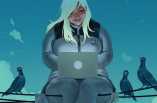
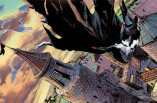
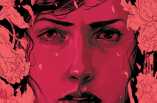
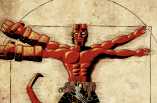

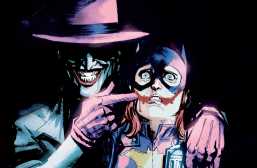
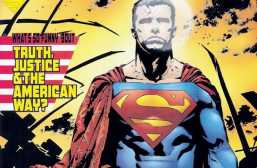
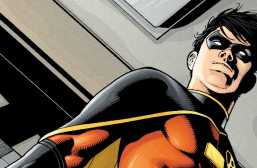
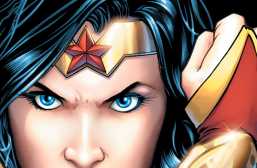
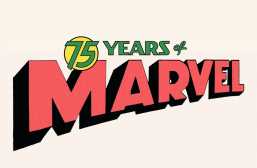
“Johnny the Homicidal Maniac” was a wonderful read. The story is just about what happens in daily life.
Fantastically morbid comic. Love.
I was first introduced to this comic in the mid-90s and loved them. I recently came across all of them re-released in book form and snapped them up.
Thanks for the read! This is my favorite graphic novel. I literally swan through the collection.
I laughed so much when reading this comic and it’s because I understand the character. I don’t know if that makes me a psycho or just sympathetic to poor Johnny.
Fantastic article. It’s interesting to see the series in this light. The hero’s journey is usually for, well, ‘heroes’. But, it can be applied to just about any protagonist (no matter how murderous he/she is).
The only issue I see is the author’s name is Jhonen, not John. Otherwise, the article is great!
Great analysis.
I remember when this came out and how difficult it was to get a copy. I did some digging and there were at least 4 reprints of the first issue, not including the Special Edition or other re-issued copies. Reprints were not as common in 1995 as they are now so reprinting an issue 4 times was almost unheard of.
Read this when I was 13 and almost got detention because of it.
While the story was gory and somewhat nightmare inducing to some, it was beautiful and carried a good message about ourselves. It’s one of my favorite books and I’ve re-read it countless times.
I’m excited to read the authors other book “SQUEE!”.
Beautiful and disgustingly great comic.
It was a poor choice to begin reading JTHM with the mindset that it would be in the same vein as Invader Zim.
I was surprised at the validity I found in some of Johnny’s moody monologues.
I can’t decide if Vasquez is completely insane or a total genius – I think he’s probably both.
This is a good analyses. Vasquez has a style that is demented and charming at the same time.
Jhonen Vasquez is my spirit animal.
It’s always amusing to re-read things you loved as a teenager and find they still hold up. This was one of those experiences.
I love the artwork and how hilariously the world is portrayed.
Great analysis using Jeffery Jerome Cohen’s seven theses. I think the first thesis is very interesting on how a monster’s body reflects a culture, and how a culture sees itself. It will be interesting to re-read monsters from throughout the ages with this historical perspective.
I’ve never heard of JTHM and I probably wouldn’t have picked it up if I hadn’t read this. Really interesting perspective!
This has some really dark humor that I’m not sure everyone would appreciate, but I think it is still worth reading.
It is a very, very quotable comic.
To this day, JTHM is still one of my favourite comics. Even though it starts out as a comic simply meant to help the artist find relief from the annoyances of daily life, it ends with a surprising amount of depth that still strikes me each time I read it. I can definitely see aspects of the hero’s journey in the comic but I’m not actually too familiar with Jeffery Jerome Cohen or his writing. It sounds like a fascinating read as the connections you draw between his conception of the monstrous and Nny is something I found particularly interesting. I especially like your points on his first thesis, how the monster’s body is a cultural body. Sometimes, I forget the time and culture JTHM came from since I originally read it about a decade later. Great write up, overall.
Nice article. This graphic novel is a good mix of gory violence, social commentary, intellectual stimulation, and just plain ol’ fucked up.
I definitely think that there’s a piece of Johnny in all of us, and that his actions represent the darker emotions in our lives that we repress. Its easy to envision someone you hate being tortured, in some way, whether or not you’re the one doing it, and Vasquez offers a humorous look at what that would look like if taken way too far. The situations Nny finds himself in are entirely out of the box and bizarre, though intriguing, and fun to read. The graphic novel is a good way to escape and reminds you to laugh a little at anger.
Great article! I look forward on reading more of your reviews!
Although I have never heard of Johnny, he sounds like quite a complex character! Your analysis was well-written and thorough. Excellent job!
Seeing Joseph Campbell applied to Jhonen Vasquez makes me all happy inside. Thank you for this.
This makes me want to re-read JTHM, as well as all of Vasquez’s other works. Well done.
When is AMC going to adapt this to a television show? This is the first time I’m heading of this title and it seems amazing. I’m looking forward to reading it.